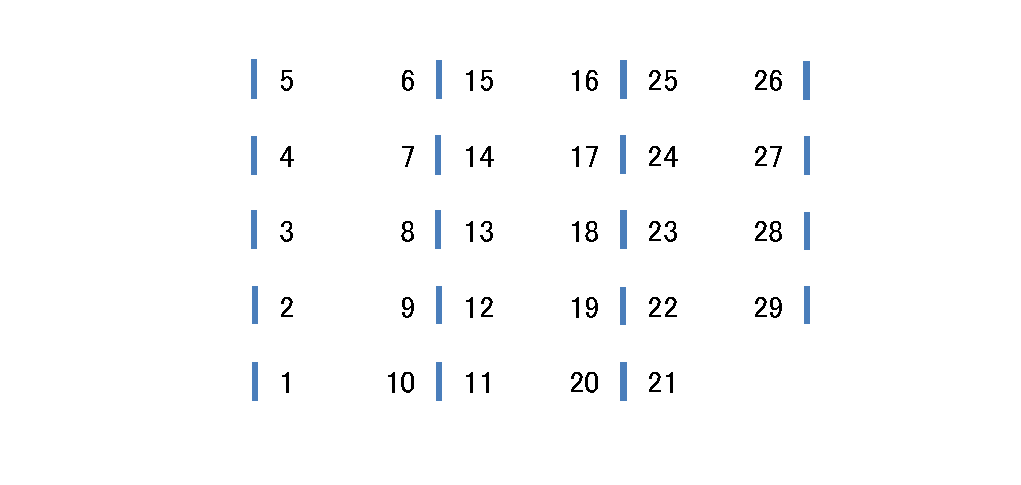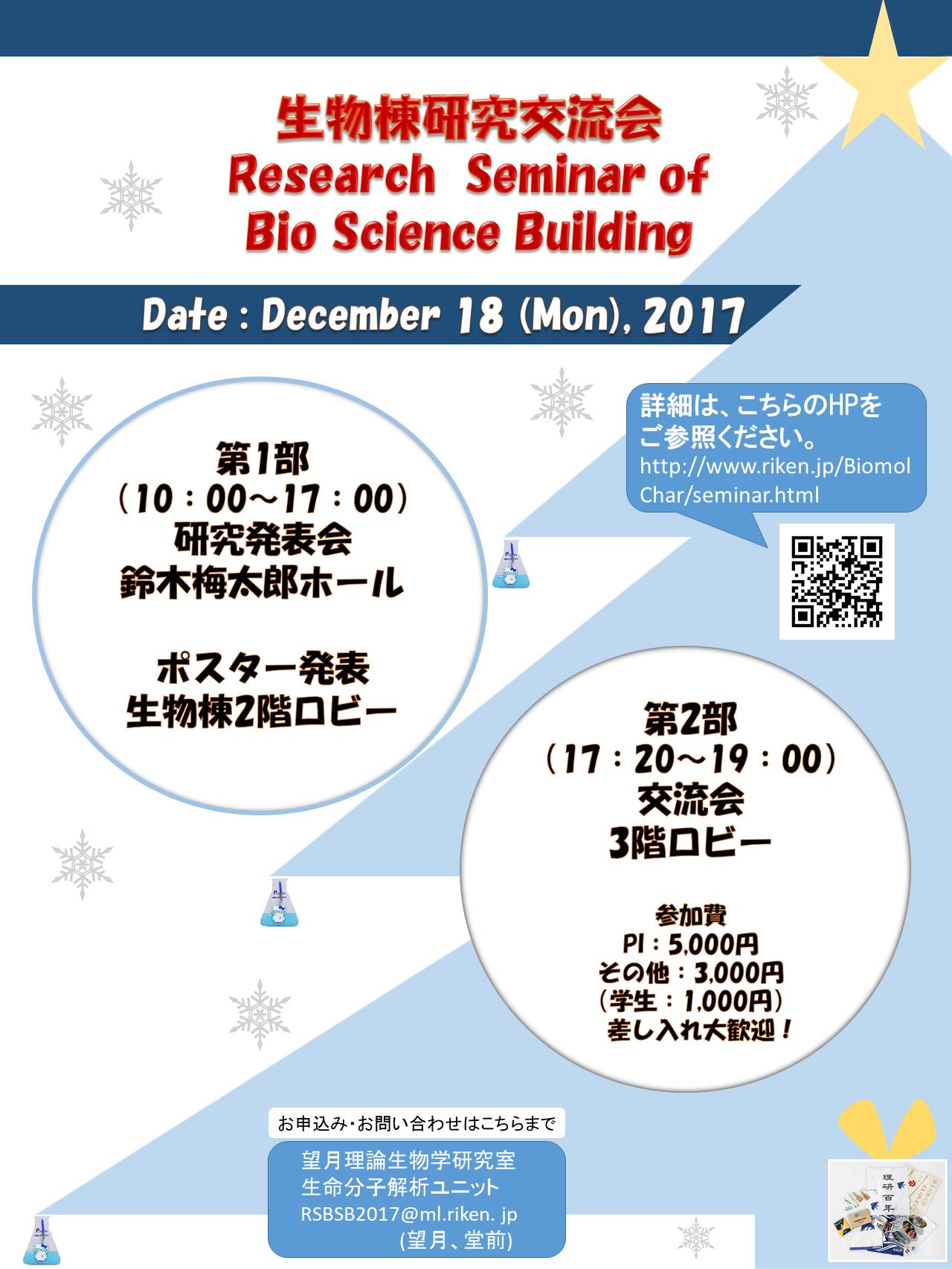
Research Seminar of Bio Science Building
Oral:Suzuki Umetaro Hall, Poster:Bioscience Bldg. 2F Lobby, Mixer:Bioscience Bldg. 3F Lobby
Contact
Theoretical Biology Laboratory
Biomolecular Charcterization Unit
Email : RSBSB2017@ml.riken.jp ( MOCHIZUKI , DOHMAE )
Program
- 10:00 - 10:05
- Opening Remarks
Atsushi Mochizuki
- 10:05 - 10:20
- Applications of mass spectrometry-based approaches for characterizing histone H3 post-translational modifications
Kwak Ho-Geun ( Biomolecular Characterization Unit, CSRS )
- 10:20 - 10:35
- Chemical biology research group activities in 2017
Junnosuke Otaka ( Chemical Biology Research Group, CSRS )
- 10:35 - 10:50
- Approach to development of “Symbiosis”-targeted environmentally-friendly control methods for agricultural pest insects
Akiko Fujiwara ( Chemical Genetics Laboratory )
- 10:50 - 11:05
- Break
- 11:05 - 11:20
- Studies on the pathologic mechanism of NGLY1-deficiency
Chengcheng Huang ( Glycometabolome Team, Systems Glycobiology Research Group, GRC )
- 11:20 - 11:35
- Plant steroid hormone signaling research by aspects of biological evolution
Takeshi Nakano ( Gene Discovery Research Group, CSRS )
- 11:35 - 11:50
- Visualizing the traffic inside the cells
Yoko Ito ( Live Cell Super-Resolution Imaging Research Team )
- 11:50 - 13:05
- Lunch
- 13:05 - 13:20
- Suv39h1-mediated Pericentric Heterochromatin Formation
Atsuko Shirai ( Cellular Memory laboratory )
- 13:20 - 13:35
- Nucleocytoplasmic transport of proteins
Makoto Kimura ( Cellular Dynamics Laboratory )
- 13:35 - 13:50
- Single-molecule imaging of membrane proteins and lipids
Mitsuhiro Abe ( Cellular Informatics Laboratory )
- 13:50 - 14:05
- Condensin II makes a primary contribution to mitotic chromosome shaping in human cells
Takao Ono ( Chromosome Dynamics laboratory )
- 14:05 - 14:20
- Getting the Essence of Natural and Engineered Systems via Illuminating Simulations
Ai Niitsu ( Theoretical Molecular Science Laboratory )
- 14:20 - 14:35
- Break
- 14:35 - 14:50
- Mechanism of temperature independence in biological clocks
Gen Kurosawa ( Theoretical Biology Laboratory )
- 14:50 - 15:10
- Quantum electronics and simulation based on superconducting circuits
Yoshiro Urade ( Superconducting Quantum Electronics Research Team, CEMS )
Hiroto Mukai ( Superconducting Quantum Simulation Research Team, CEMS )
- 15:10 - 15:25
- Move from Yamagata at this August and a little bit about LEDs made by printing technique
Yong-Jin Pu ( Emergent Supramolecular Materials Research Team, CEMS )
- 15:25 - 15:40
- Genome-wide understanding of translation
Shintaro Iwasaki ( RNA Systems Biochemistry laboratory )
- 15:40 - 17:00
- Poster Session (Bioscience Bldg. 2F Lobby)
- 17:20 - 19:00
- Mixer (Bioscience Bldg. 3F Lobby)
Poster

Temperature dependence of nuclear transport system
Yutaka Ogawa ( Cellular Dynamics Laboratory )
Extensive cargo identification reveals distinct biological roles of the 12 importin pathways.
Makoto Kimura ( Cellular Dynamics Laboratory )
Global understanding of translation using ribosome profiling
Iwasaki lab ( RNA Systems Biochemistry laboratory )
Structure and resistance of an mRNA-selective natural translation inhibitor for Aglaia
Iwasaki lab ( RNA Systems Biochemistry laboratory )
Plant chemical biology research of brassinosteroid signaling factor BIL7 that promoted plant inflorescence elongation
Tomoko Miyaji ( Gene Discovery Research Group, CSRS )
AmPR1, a seven-transmembrane protein, as a possible progesterone receptor in Arabidopsis
Ayumi Yamagami ( Gene Discovery Research Group, CSRS )
Exploration of the catalytic landscape of Diels-Alderase
Naoki Kato ( Natural Product Biosynthesis Research Unit, CSRS )
Screening for small-molecule inducers of reactive oxygen species
Tatsuro Kawamura ( Bioprobe Application Research Unit, RIKEN-Max Planck Joint Research Division for Systems Chemical Biology, CSRS )
Analysis of NF-kB clusters formation in the cell nucleus.
Takehiko Inaba ( Cellular Informatics Laboratory )
Quantitative measurements of cortical flow during animal development
Yukinobu Arata ( Cellular Informatics Laboratory )
Cellular Memory laboratory
Cellular Memory laboratory ( Cellular Memory laboratory )
How a small change in ligand functional groups can affect the dynamics of an aminoglycoside riboswitch
Marta Kulik ( Theoretical Molecular Science Laboratory )
Dimer conformation sampling of FGFR3 Transmembrane domain using MD simulation
Daisuke Matsuoka ( Theoretical Molecular Science Laboratory )
Spatio-temporal dynamics of coat and adaptor proteins on the trans-Golgi network
Takuro Tojima ( Live-Cell Super-Resolution Imaging Research Team )
Observations of the membrane traffic in living yeast cells via the high-speed super-resolution optical microscope
Daisuke Miyashiro ( Live-Cell Super-Resolution Imaging Research Team )
Singlet Exciton Fission of Thienoquinoidal compounds in Organic Photovoltaics
Yong-Jin Pu ( Emergent Supramolecular Materials Research Team, CEMS )
Simulation of XY models using Josephson junction arrays in circuit QED architecture
Cosmic Raj ( Superconducting Quantum Electronics Research Team, CEMS )
Single microwave-photon detector using an impedance-matched Λ system
Kunihiro Inomata ( Superconducting Quantum Electronics Research Team, CEMS )
The bacterial SMC complex: structure and functions
Katsuhiko Kamada ( Chromosome Dynamics laboratory )
Mitotic chromosome assembly without nucleosomes
Keishi Shintomi ( Chromosome Dynamics laboratory )
Introduction to outline of Yoshida-Lab’s researches
Chemical Genetics Laboratory ( Chemical Genetics Laboratory )
Origin of cell diversity: Expected number of fixed points in Boolean networks
Fumito Mori ( Theoretical Biology Laboratory )
Mathematical Modeling of Retinal Cellular Mosaic Pattern Formation
Noriaki Ogawa ( Theoretical Biology Laboratory )
Applications of mass spectrometry-based approaches for characterizing histone H3 post-translational modifications
Kwak Ho-Geun ( Biomolecular Characterization Unit, CSRS )
Direct identification and quantitation of RNA post-transcriptional modifications at a single-nucleotide resolution
Hiroshi Nakayama ( Biomolecular Characterization Unit, CSRS )
Occurrence of free sialyl oligosaccharides related to N-glycans (sialyl FNGs) in animal sera
Junichi Seino ( Glycometabolome Team, Systems Glycobiology Research Group, GRC )
Studies on the pathologic mechanism of NGLY1-deficiency
Chengcheng Huang ( Glycometabolome Team, Systems Glycobiology Research Group, GRC )
Study on Scalable One-way Quantum Computation in Circuit QED
Keiichi Sakata ( Superconducting Quantum Simulation Team )
Superconducting Qubits Coupling via Lumped Element Resonators toward Quantum Annealing
Akiyoshi Tomonaga ( Superconducting Quantum Simulation Team )
Mixer
- PI : 5,000 JPY
- Regular : 3,000 JPY
- Student : 1,000 JPY
